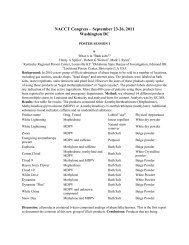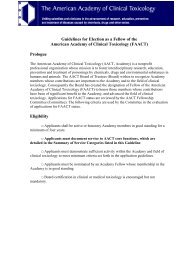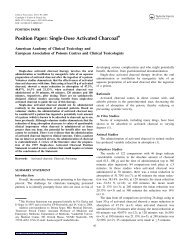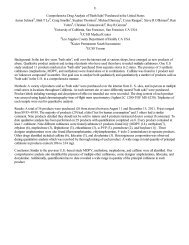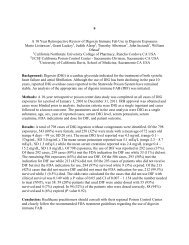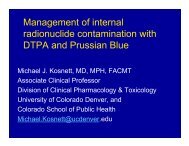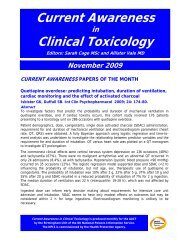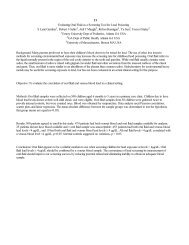Posters IV - The American Academy of Clinical Toxicology
Posters IV - The American Academy of Clinical Toxicology
Posters IV - The American Academy of Clinical Toxicology
Create successful ePaper yourself
Turn your PDF publications into a flip-book with our unique Google optimized e-Paper software.
elative to usual rise seen with hepatic injury and led to premature discontinuation <strong>of</strong> <strong>IV</strong> NAC therapy.<br />
Conclusion: Onset <strong>of</strong> rise <strong>of</strong> AST/ALT beyond 24 hours post ingestion may occur in large acetaminophen<br />
overdose.<br />
311<br />
Pr<strong>of</strong>ound Hydroxychloroquine Toxicity with Resistance to Sedation with High Dose Diazepam<br />
Melissa Halliday 1 , Kris Nanagas 1 , Zack Worley 1 , David Burns 2<br />
1 Indiana University School <strong>of</strong> Medicine, Indianapolis IN USA<br />
2 Indiana Poison Information Center, Indianapoliis IN USA<br />
Background: Hydroxychloroquine is a synthetic 4-aminoquinoline derivative used as an<br />
antirheumatologic agent. Hydroxychloroquine ingestions are rarely seen, but result in rapid toxicity and<br />
high rates <strong>of</strong> mortality. Case Report: A 32 year-old female attempted suicide by ingesting 18g <strong>of</strong><br />
hydroxychloroquine. On initial presentation her blood pressure was 66/47 with a heart rate <strong>of</strong> 90, however<br />
quickly fell to 31/16 despite 2 liters <strong>of</strong> crystalloid replacement. She was intubated, placed on an<br />
epinephrine drip and given a 2mg/kg diazepam bolus, followed by continuous diazepam infusion at<br />
5mg/hr. Her initial ECG revealed QRS at 148ms and QTc <strong>of</strong> 642ms, which was treated with sodium<br />
bicarbonate and magnesium sulfate. Her initial potassium level was 3.9 mmol/L, however reached a nadir<br />
<strong>of</strong> 1.6mmol/L four hours later. This hypokalemia ultimately required treatment with a total <strong>of</strong> 199 mEq <strong>IV</strong><br />
potassium. Initial serum phosphorus was 1.0mg/dL, which stabilized after treatment with 21 mmol <strong>of</strong><br />
potassium phosphate. Most notably, following a 140mg bolus <strong>of</strong> intravenous diazepam and 5mg/hr<br />
diazepam infusion, the patient remained awake and was attempting to mouth words around her<br />
endotracheal tube. She was later discharged neurologically intact. Case Discussion: Hydroxychloroquine<br />
is a rarely described but serious and rapidly fatal cause <strong>of</strong> overdose. One case series <strong>of</strong> 6 moderate to<br />
severe overdoses estimated the lethal dose to be 4g. Our patient ingested 18g <strong>of</strong> hydroxychloroquine and<br />
exhibited severe hypotension, ECG abnormalities and severe electrolyte derangement within 1 hour <strong>of</strong><br />
ingestion. While decreased mortality has been noted with high dose diazepam treatment in chloroquine<br />
overdose, its efficacy in hydroxychloroquine ingestion has not been well explored. Our patient had clinical<br />
improvement in her blood pressure and ECG after administration; however she remained awake and alert<br />
despite large doses <strong>of</strong> this sedating medication. It has been suggested previously that chloroquine has an<br />
antagonistic effect on benzodiazepine sedation. Chloroquine's chemical structure is similar to compounds<br />
that inhibit benzodiazepine binding at certain receptors, possibly attributing to the diminished sedation<br />
noted in overdose. Conclusion: This case is remarkable for the degree <strong>of</strong> toxicity and the diminished<br />
sedation response to high dose diazepam. This is one <strong>of</strong> the most severe toxicities with patient survival<br />
documented in the literature. <strong>Clinical</strong> improvement was noted after administration <strong>of</strong> high dose diazepam<br />
but sedation was not achieved. This warrants further study <strong>of</strong> the mechanism <strong>of</strong> toxicity in<br />
hydroxychloroquine overdose.<br />
312<br />
Intractable seizure following dalfampridine ingestion: Case Report<br />
Jeffrey L Bargeon, Cynthia K Aaron<br />
Background: Dalfampridine (4-aminopyridine or 4-AP) is a broad-spectrum potassium channel blocker<br />
believed to enhance action potential transduction in demyelinated neurons via potassium channel<br />
inhibition. Daily dose is 10mg; doses greater than 10 mg may cause seizures. We report an overdose<br />
leading to prolonged status epilepticus and death. Case Report: A 45-year-old male presented to the ED



